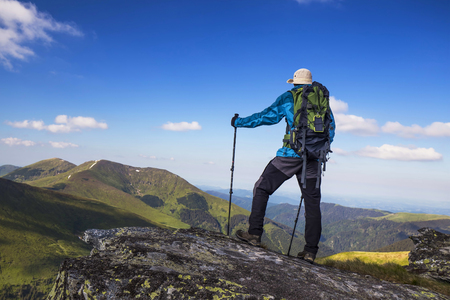Understanding UK Hillwalking and Trekking Essentials
If you’re itching to tackle the wild, wind-battered fells of the Lake District or the rugged ridgelines of Snowdonia, understanding what sets British hillwalking and trekking apart is your first rite of passage. The UK’s landscapes are famously diverse—one moment you’re scrabbling up rocky tors in Dartmoor, the next you’re wading through boggy moorland on the Pennine Way. Unlike the predictable trails abroad, British terrain throws everything at you: slippery stones, thick heather, sudden scree slopes, and ancient drystone walls that stand defiant against the elements. And then there’s the legendary weather—four seasons in a single afternoon isn’t just a joke here. From howling gales on Scottish Munros to relentless drizzle on Yorkshire’s dales, your kit can make or break your adventure.
When it comes to rucksacks, this isn’t about flashy gear for show—it’s about survival and comfort. In Britain, bag choice is a matter of strategy: can it withstand lashing rain, carry all your wet-weather kit, and endure being dumped in mud during a hasty lunch stop? Every gram counts when you’re slogging up Ben Nevis with biting wind in your face. A rucksack that lets you move fast but also keeps your sarnies dry is worth its weight in Kendal Mint Cake. So before you dream of conquering iconic peaks or venturing off-trail into remote valleys, get ready to choose your rucksack like a true British adventurer—prepared for anything our hills can throw at you.
2. Key Features to Look for in a Hillwalking Rucksack
When venturing into the unpredictable wilds of the UK—be it the Lake District’s sodden fells, the windswept Cairngorms, or the rugged peaks of Snowdonia—your rucksack is your lifeline. The right pack can mean the difference between a triumphant summit and a gruelling retreat. Here’s what you must scrutinise before strapping in for another British hillwalking adventure:
Waterproofing: Stand Firm Against the Elements
British weather is legendarily fickle. Your rucksack needs to be as unyielding as Scafell Pike in a storm. Look for fully waterproof materials or at least water-resistant fabrics paired with rain covers. Sealed seams and waterproof zips are essential if you want to keep your kit dry when the heavens inevitably open.
Back Support and Comfort: Conquer Miles Without Regret
A proper back system isn’t just about comfort—it’s about survival on marathon treks. A well-ventilated, padded back panel helps prevent sweat-soaked misery, while an ergonomic fit ensures your pack moves with you, not against you. Adjustable hip belts and sternum straps distribute weight evenly, letting you scale scree slopes or scramble over stiles without losing your edge.
Adjustable Straps: Custom Fit for Every Adventure
No two hillwalkers—or hills—are quite alike. Adjustable shoulder, chest, and waist straps allow you to tailor your rucksack to your body and load, reducing fatigue on those relentless ascents. Compression straps also help stabilise your kit whether you’re carrying a minimalist day pack or are geared up for a multi-day trek.
Capacity: Pack Smart for British Terrain
| Walk Type | Recommended Capacity (Litres) | Essentials |
|---|---|---|
| Day Walks & Short Hikes | 20-30L | Waterproofs, lunch, OS map, first aid kit |
| Long Hillwalks | 30-45L | Add extra layers, stove, head torch, flask |
| Multi-Day Treks & Wild Camping | 50L+ | Tent/bivi bag, sleeping bag/mat, full cooking kit |
Pockets & Access Points: Organisation Is Everything
Battling through boggy moors or scrambling up crags demands quick access to snacks, maps, and waterproofs. Opt for a rucksack with easy-access side pockets, hip-belt pouches for nibbles or compass, and separate compartments to keep wet gear away from dry.
Toughness: Built for Britain’s Battered Trails
The best rucksacks are constructed from abrasion-resistant fabrics that won’t flinch at bramble thickets or granite outcrops. Reinforced bases add extra resilience where it matters most—so your pack survives more than just one season of adventure.
Selecting a rucksack equipped with these key features will see you ready to tackle anything the British hills can throw at you—from sideways rain to sudden descents—all while keeping your spirit (and socks) dry.

3. Choosing the Right Size and Fit for British Adventures
If you’re serious about conquering the fells of the Lake District or braving the windswept wilds of Dartmoor, getting the right rucksack size and fit is non-negotiable. This isn’t just about comfort – it’s about survival, stamina, and squeezing out every drop of adventure from Britain’s rugged terrain.
Understanding Rucksack Capacity: One-Day Jaunts vs. Multi-Day Epics
For a classic British hillwalk or a single-day stomp up Snowdon, a 20-30 litre pack is typically spot on. It’ll swallow your waterproofs, a hearty packed lunch, flask of tea, OS map, and a few emergency supplies without weighing you down. But if you’re setting your sights on multi-day treks – think Pennine Way or wild camping across the Highlands – you’ll want to size up to 40-60 litres. That extra space ensures you can stash a sleeping bag, stove, change of kit, and all those little luxuries that keep spirits high when the weather turns foul.
Fit: The Unsung Hero of Comfort
A well-fitted rucksack makes all the difference on a relentless British ascent. Look for adjustable back systems to match your torso length – most brands offer men’s, women’s, and even short-back versions. Shoulder straps should hug snugly but never chafe; hip belts must carry most of the weight so your shoulders aren’t left doing all the graft. Sternum straps add stability when scrambling over scree or hopping stiles in the Dales.
Pro Tip: Try Before You Buy
Head to your local outdoor shop (yes, even in this online age) and load up prospective packs with some weight. Wander round the shop, climb some stairs if they’ve got them, and see how each model moves with you. A good fit now means less faff and fewer blisters when you’re miles from civilisation.
Packing for British Weather – Leave Room for Surprises
Our weather is famously unpredictable, so always allow for a bit of extra space in your pack. A compressible waterproof jacket, insulated layer, gloves and hat might not seem essential at breakfast but can be lifesavers by afternoon atop Ben Nevis or Skiddaw.
Remember: choose a rucksack that fits not just your back but your ambitions. Whether it’s a Sunday stroll on Kinder Scout or an epic journey along the West Highland Way, nailing size and fit sets you up for adventure – rain or shine.
4. Top British Rucksack Brands and Models
When it comes to braving the rugged fells of the Lake District, or taking on the ever-changing moods of Snowdonia, the right rucksack can be your greatest ally. Across the UK’s wild places, certain brands have become almost legendary among hillwalkers and trekkers for their durability, fit, and resilience against classic British weather. Here we spotlight some of the most reputable UK and European rucksack brands, along with their standout models that are consistently trusted by those who know the hills best.
Leading UK and European Rucksack Brands
| Brand | Origin | Why It’s Trusted |
|---|---|---|
| Berghaus | UK | Iconic for robust construction; widely used by British hikers since the 1970s |
| Lowe Alpine | UK (now global) | Pioneered innovations in pack design; known for comfort and technical features |
| Karrimor SF | UK | Favoured by military and expedition leaders; built to withstand the harshest conditions |
| Montane | UK | Sleek, lightweight packs designed for endurance walking and fell running |
| Osprey Europe | European HQ in UK/US brand | Highly adjustable, superb support; a go-to for serious trekkers across Britain |
| Deuter | Germany | Renowned for ventilation systems and ergonomic design; popular among UK walkers tackling long distances |
| Lowe Alpine | UK (originally) | A heritage brand with a loyal following for both daypacks and expedition sacks |
| Rab Equipment | UK | Bags built for mountain environments; practical features tailored to British needs |
Rucksack Models Favoured by British Hillwalkers & Trekkers
| Model Name | Best For | Capacity Range (Litres) |
|---|---|---|
| Berghaus Freeflow Series | Day walks, weekend adventures; famed airflow back system keeps you cool even on sweaty climbs up Helvellyn. | 20–35L |
| Lowe Alpine AirZone Trek+ | Trekking routes like the Pennine Way; super comfy harness and ventilated back panel. | 35–45L+ |
| Karrimor SF Sabre 45L / Predator 30L | Tough multi-day expeditions or military-grade reliability on Dartmoor. | 30–70L (expandable options) |
| Osprey Talon/Tempest Series | Lakeland scrambles to Scottish Munros; renowned adjustability, perfect fit for men & women. | 11–44L |
| Montane Trailblazer Series | Fastpacking and ultra-light trekking on the South West Coast Path. | 18–44L |
The Value of Local Expertise: Why These Brands Matter in the UK Hills
The difference between a memorable day out and a miserable slog often comes down to kit choices. These brands haven’t just earned their reputation through slick marketing – they’ve been tested relentlessly by hillwalkers battling sideways rain in the Brecon Beacons or picking their way over boggy moors in Northumberland. Their models reflect decades of feedback from British users who need gear that copes with unpredictable weather, gnarly terrain, and long hours under load. When you shoulder up a pack trusted by UK outdoorsfolk, you’re carrying a bit of local heritage – engineered not only for adventure, but for survival in our wildest places.
5. Packing Like a Pro: Organisation Tips for UK Walks
Mastering the Art of Efficient Packing
If you’re tackling the rugged ridges of Snowdonia or yomping through the wind-battered Highlands, packing your rucksack smartly isn’t just a luxury—it’s essential. The British hills are notorious for their changeable moods, so let’s embrace that spirit of adventure and outsmart the elements with these pro-level packing strategies.
Must-Have Accessories for British Hillwalking
- Waterproof Dry Bags: Even if your rucksack claims to be waterproof, trust no one—pack your kit in dry bags to keep everything bone dry when the heavens open.
- Rain Cover: A rucksack rain cover is your best mate against sudden downpours. Keep it easily accessible at the top or in an outer pocket.
- Map & Compass Case: British fog can roll in without warning. A waterproof case keeps your navigation tools handy and legible even when visibility drops to zero.
- First Aid Kit: Always within reach, ideally packed near the top or in a dedicated external pocket for quick access during emergencies.
Clever Kit Organisation: Get Tactical
- Lining Up Your Load: Heavier items, like water bladders and food, go close to your back and centred vertically—this keeps your centre of gravity stable on uneven ground.
- Layered Approach: Pack spare layers and waterproofs at the top or in side pockets—you’ll need them quickly when that classic British drizzle turns into a squall.
- Pocket Power: Use hip belt pockets for energy snacks, gloves, or your phone. Stash headtorches, hats, and buffs where you can grab them without stopping.
Packing For Unpredictable Weather & Wild Routes
The beauty (and challenge) of UK trekking is that you can experience four seasons in a day. Prepare for every eventuality by packing kit in logical, weather-ready zones. Reserve one compartment for wet gear—nothing ruins morale faster than soggy sandwiches—and keep essentials like hats and gaiters at hand for sudden boggy stretches or biting winds. Above all, review and refine your system after every walk; real adventure is about learning what works best on Britain’s wildest trails.
6. Care and Maintenance to Withstand British Weather
Why Upkeep Matters on UK Trails
Hillwalking and trekking across the UK can test even the hardiest rucksacks, with relentless rain, mud, and the ever-present threat of boggy ground. Keeping your kit in top nick is not just about pride—it’s about survival and comfort on those wild, windswept ridges. A well-maintained rucksack won’t let you down when the heavens open or the path turns to mush.
Cleaning Off British Grime
After a sodden trek through Dartmoor or a blustery stomp in the Lake District, your rucksack will almost certainly be caked in mud and grit. Start by emptying every pocket and giving it a good shake outdoors. Use a soft brush to remove dried mud, then sponge down with lukewarm water and a mild soap—no harsh detergents, as these can damage waterproof coatings. Always let your rucksack air dry thoroughly indoors, away from direct heat sources like radiators or open fires, which can warp straps and buckles.
Waterproofing: Your First Line of Defence
The UK’s notorious drizzle demands more than just hope. Regularly re-proof your rucksack using sprays or wash-in products designed for outdoor gear. Pay extra attention to seams and zips, which are common weak points. Even if your pack boasts a built-in rain cover, it’s wise to treat the main fabric at least twice a year—or after any particularly gruelling expedition through Scottish downpours.
Repairs: Keeping Kit Battle-Ready
Torn straps or busted buckles can spell disaster miles from civilisation. Carry a basic repair kit—think needle and thread, duct tape, safety pins, and spare clips—on every outing. Back home, patch up any holes with specialist fabric patches or strong adhesive tapes made for outdoor use. For stubborn zip issues, a dab of candle wax works wonders. Don’t ignore minor niggles; they’ll only get worse on your next adventure over the fells.
The Final Word: Longevity Pays Off
A bit of regular TLC will see your rucksack outlast countless seasons of British wind and weather. By cleaning, waterproofing, and repairing as needed, you’ll ensure your trusty bag is always ready for whatever wild mischief the UK hills have in store—rain or shine.


